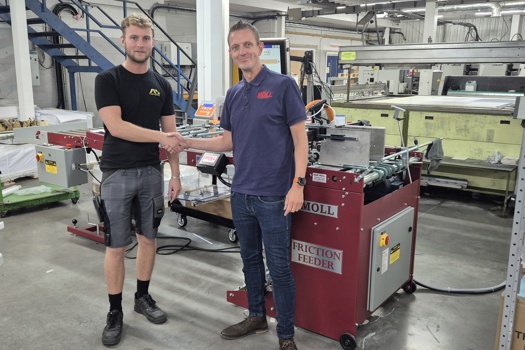For the past year, Stephen Connor, studio manager at Wyke Printers, has spent his Friday afternoons sitting at his computer sending detailed emails about how his web-to-print system could be improved.
It’s the sort of ritual that those who have experienced nightmare installations of new kit will know well. However, in this case, all is not as it seems. For rather than an unhappy customer, Connor is part of a relationship that aims to prevent exactly the aforementioned nightmare new-kit scenarios. Wyke Printers, you see, is a beta test site for Fuji’s XMF Print Centre.
As shown by Connor’s weekly dedication to alerting Fuji to problems and to making improvement suggestions, the job of the beta site is never easy. Getting a fledgling machine or product ready for market can be stressful and time-consuming and, while there are upsides to being the beta site, the benefits are not always as extensive as you may think. Choosing to become a beta, then, is something that needs to be gone into for the right reasons, and managed so that the maximum benefit can be gained. It might be assumed that the number-one benefit to being a beta tester would be discounted kit. And this is sometimes true in part, says Wyke’s Connor.
"We spent about a year and a half looking at different web-to-print packages and we couldn’t find one that fitted exactly what we wanted it to do, so we realised we wanted a bespoke package, but we also knew it would cost us," he explains. "Being a beta for XMF Print Centre was a compromise between a bespoke package and an off-the-shelf solution, because it was heavily discounted."
But to see a beta-tested bit of kit or software package as straightforwardly cheaper is problematic, explains Connor. Beta testing involves constantly having engineers onsite, reporting to them and never quite knowing whether you can fully rely on your equipment, and printers should also not underestimate the cost associated with these inconveniences.
"I found that you couldn’t really see it as a means of getting a bargain, because the reality is that you’re not getting one, because of the amount of time you have to put in. Human time still has a price on it," he says.
Significant drain on resources
Gary Peeling, managing director at Precision Printing, a company garnering much attention of late for being one of the first beta testers of the new HP Indigo 10000, agrees that the costs of beta testing can be high.
"In order to be an effective beta partner, you have to make significant resources available for reporting, so twice-weekly conference calls, plus report taking – and that all costs," he says.
He adds, as do others, that Connor is also fortunate in getting a discount price for being the beta site, as this is relatively rare. Price, then, can be ruled out as being an incentive for a printer to sign up to become a beta site.
Fortunately, it is not cost savings that many of those that have taken the plunge were seeking. Much more of a draw is being at the forefront of new technology and thereby being able to offer something few others can.
This was certainly Precision’s logic in agreeing to test the new B2 printer. Peeling explains why being first to buy is worth the cost and hassle of being a beta tester:
"The 10000 allows us to do a range of products and formats that just weren’t possible using an Indigo before; landscape-A4 books, folders with wallets and a lot of self-mailer formats," he says. "There are some digital machines that can produce these off a roll but that’s not quite the same thing."
He adds that this means Precision is now one of only a few companies that can offer these products as short-run and at the quality of which the Indigo is capable.
And even with entry-level kit, these benefits can apply: being first to market with a new way of doing something, or a new product, gives you the advantage over competitors.
However, clearly not all machines that need beta testing are designed to open a new market. Most new kit and software simply increases the speed at which a process can be performed, and this added efficiency won’t, in all likelihood, really be gained until the equipment has been finessed at the end of a six-month or year-long test period.
In this situation, it seems foolish for a printer to put themselves through the hassle of the beta period when they are seemingly better off waiting for the product to be ready and then making a purchase.
But it is a little more complicated than that. In many printers’ experience, the kit that they end up with after beta testing won’t be exactly the same as the kit they’d have got off the shelf a year or so down the line. That is, through the process of continually tweaking equipment according to a printer’s suggestions, manufacturers will end up tailoring the package not only to be better suited to all printers’ needs, but to the specific needs of that particular print shop.
Wyke’s Connor reports this was the case with his web-to-print solution, with the package ending up even better tailored to Wyke perhaps than if he’d signed up for a bespoke Fuji XMF Print Centre once it was on the market.
Influence on development
And Clays, a company that recently beta tested the Kodak Prosper 1000 with Muller Martini Sigma line, agrees that this is a perk well worth extra time and money.
"Beta testing can give you an advantage because you get something good and early, but it can also mean that you can to some extent influence and tailor-make the machine to your own needs," says managing director Kate McFarlan.
Some argue it goes even further than this bespoke tailoring. Beta machines, they say, are fine-tuned to a level of perfection beyond that of a regular install, due to the impact the performance of that machine will have on future opinions and sales of that machine.
Lawrence Dalton, managing director at 1st Byte digital printers, likens this to buying a machine that’s previously been a show model.
"A point made to me once by engineers was that you should buy machines from Drupa or Ipex because manufacturers spend an awfully long time making those machines as perfect as perfect can be," he says, explaining that the same logic applies with beta-tested kit. "They want to make the transport system and the imaging systems as perfect as possible so the mass market will hear such great things that they’ll buy at a later stage."
This ‘extra mile’ service extends beyond the beta period, reveals Peeling.
"You build up very good contacts with the actual R&D department, rather than the local sales rep," he explains. "Those are the more valuable contacts even beyond the beta-testing period, because you know who to contact when you have an issue and at what level, and you’re able to cut through some of the local bureaucracy."
He adds that frequent discussions with these highly placed engineers also improves the printer’s working knowledge of the machine.
"The time you spend talking to the people who are designing the technology dramatically increases your understanding of how everything works and your ability to fix it," adds Peeling.
In the light of all of these pros, becoming a beta tester seems like an increasingly good idea. And, with the ball lying firmly in the manufacturer’s court in terms of who is felt to provide the best beta environment, the opportunity doesn’t come along every day and printers may be tempted to jump at the chance.
But caution is needed. The benefits will not be reaped, say those with beta testing experience under their belts, unless printers make sure they bear some considerations in mind.
The most important is to make sure there is in fact a business case for installing the machine. This is crucial, of course, where the printer is embracing a brand new offering.
Alistair Ezzy, business development director at mailing house GI Solutions, advocates this advice. He explains that GI thought long and hard about the appetite for variable imagery on marketing materials before agreeing to beta test a Screen Truepress Jet250 in 2007.
"A lot of customers will say a certain product is what they want, but it’s not their money and clients often change their mind when they see the product for real," warns Ezzy. "A lot of people can imagine where they want to be but that’s often not today or tomorrow, it’s normally a bit further down the line than the person paying or the machine wants it to be."
Considering that they will probably end up forking out just as much if not more for the kit than if investing normally, the business case for a beta-tested piece of equipment should, then, be as thoroughly thought out as for any other installation.
"You’ve got to justify beta-test kit as if you were investing in the usual way," confirms Ezzy. "You need to ask: if it produces this sort of product, what will my market be? How much will I have to sell to pay for the thing? There’s no point in beta testing something and thinking ‘that worked really well but I can’t sell the print for the right price’, or ‘I haven’t got the volume’."
Dangerous mentality
This may sound like obvious advice but it is in fact easy, say many, to get carried away with the idea of being ahead of the competition or with the idea of owning a perfectly engineered machine. A trap that many fall into is mistaking the test period for a risk-free opportunity to test the business case for installing a machine. That is, because the typical arrangement is that the printer will only actually pay for kit once the agreed test period has elapsed, with unhappy printers perfectly at liberty to return it, many see this as a low-cost way of testing a new offering.
But this is a dangerous mentality, points out Peeling. "Even if you step away, you’ve already gone through an awful lot of work preparing the site – putting in wiring for instance – and there’s no compensation for that," he says, explaining that to dramatically lessen the risk of these costs being in vain, a printer should ensure the only thing being tested is whether the technology works or not.
Another key consideration in ensuring all of the potential benefits of becoming a beta tester are actually enjoyed, is who the relationship is with. Wyke’s Connor reports that crucial to his positive experience has been working with a company he already knew well and trusted, and that this really paid off when Wyke requested an extension of their test period.
"Fuji didn’t try and push us when we said we wanted a six- rather than three-month trial period, and when we wanted to extend that to a year," he says. "We already had a very good relationship with Fuji so we knew that, rather than it being pie in the sky and us saying ‘it would be great if it could do this’ and them saying ‘yeah yeah, okay’ and the conversation forgotten about, they would actually meet our demands."
But regardless of how trusted a beta partner is, printers should "read the small print", qualifies Connor, to ensure that the standard the manufacturer is aiming for at the end of the test period is one they will also be happy with.
"You have to have a page of expectations in terms of what quality, output and uptimes are expected," agrees Peeling. "Otherwise it’s open to interpretation on both sides and that’s where disputes creep in."
Finally, and perhaps most importantly, there is the matter of how customer expectations are managed. Printers will understandably be keen to put their machine to work, but they need to be careful not to let clients down. Otherwise, again, the benefits of being at the forefront of technology, or having a perfectly finessed machine, will be undermined.
Clay’s McFarlan says that, to avoid disappointing clients, printers should always have a back-up option, pointing out that for this reason beta testing may be less suitable for smaller printers with less kit.
"You certainly wouldn’t want to beta test a piece of equipment that stood between you and customer failure," she says. "So we’ve always had back-up while we’ve been developing a machine. We wouldn’t do beta testing otherwise."
But, of course, the nature of beta testing means that there may not always be another way of producing exactly the same product, and those testing entry-level machines will necessarily be smaller firms without perhaps the same back-up equipment. Here it will be a matter of planning ahead and making customers aware of the situation, says Connor.
"The rule of thumb is to be honest, and then if customers don’t want to be part of it at least they’ve got the option of opting out," he says. "Whereas if you hide it from them and something goes wrong, you’ve got real problems."
So the question of whether to beta or not to beta boils down a great deal to a printer’s customers. Those with close relationships with their clients will probably find a more sympathetic audience when things go slightly awry, and are less likely to risk losing future work. And these established clients might even be happy to get involved in providing feedback to the manufacturer where appropriate, reports Connor.
But, most importantly, considering the customer before agreeing to beta test is key because this will ensure, as with any installation, that there is a sound business case for investing and for going through the rigmarole and potentially actually higher costs of testing.
While a ‘free-trial’ period, a potential new market and a perfectly engineered machine all sound appealing, none of these will prove beneficial unless the printer can, by working with a trusted vendor, pass the benefits on to the customer.
The good side
- A machine or system tailored to your bespoke needs
- A head start in a new technology or in selling to a new market
- Established relationships with engineering experts for that machine or system
- A better working knowledge of the kit
- A more finely tuned machine or system than the average installation
The bad side
- Far from being a discount purchase, costs can be substantial, thanks to the price of installing the systems and infrastructure for the beta period to work
- It is time-consuming to report and feed back all the findings
- Potential problems if the market is not ready – there is a danger you will have installed a press or system that you cannot fill
- Beta machines or systems are in the development stage, so problems in meeting customer orders due to machine or system failure need to be thought through
- Being a beta site will generally see you thrust into the limelight, so, if you are a company that likes to stay below the radar, this may not be for you










